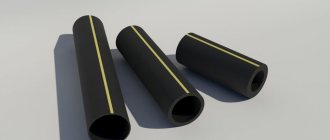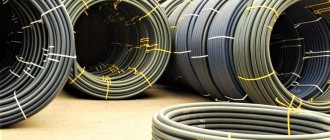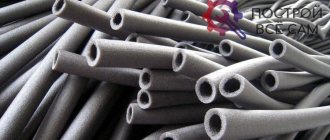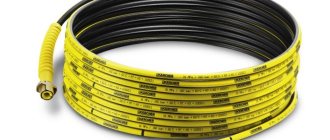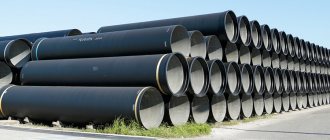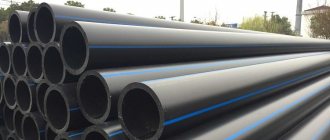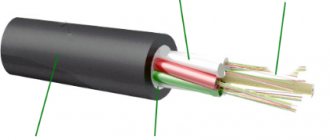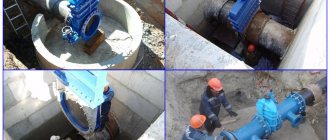Polyethylene pipes for gas pipelines are products that are manufactured by continuous extrusion. Such pipes are used when laying various pipelines for gas transportation. Today, due to their technical characteristics and relative cheapness, PE products have gained great popularity in various industries (including gas supply).
Polyethylene pipes are suitable for installation of various communications, including gas networks
Main advantages and disadvantages
Like any other product, PE gas pipes are distinguished by a number of positive qualities that determine their effectiveness. Let's look at the main advantages of this product:
- are resistant to corrosion, unlike many metal pipes;
Note! The low weight of such products makes their transportation, storage and installation as simple as possible. Steel pipes, due to their weight, are difficult to install and transport, and therefore preference is increasingly being given to PE products.
- Installation of such pipes is simple. In addition, the speed of installation work for polyethylene parts is higher when compared with metal pipes;
- polyethylene is resistant to aggressive chemicals and does not require additional electrochemical protection;
- do not require installation of waterproofing materials, as they themselves have excellent characteristics;
- polyethylene parts comply with all state quality standards;
- The smooth walls of such products provide high throughput rates. Unlike metal parts, salt deposits and other particles that narrow the lumen of the pipe do not settle on their walls;
- polyethylene pipelines are environmentally friendly and do not emit harmful substances that can cause harm to human health.
- The service life of polyethylene pipelines is significantly higher than that of metal analogues. Under normal use, it can reach 50 years, and in some cases more ;
- the cost of such products is lower than that of metal ones, which is a fundamental factor for many construction companies.
- It is also worth mentioning that they are characterized by low air and gas permeability indicators. This is a very important point, given the fact what kind of medium is transported through polyethylene gas pipelines.
Gas PE pipes are produced by extrusion and have high performance characteristics
Now let's look at the main disadvantages of polyethylene products:
- installation of polyethylene communications should be carried out only using the underground (closed) method;
- such pipes have good temperature resistance, however, their use is not recommended for sudden temperature changes. This is especially true for low temperatures;
- In addition, there are restrictions on the depth of laying such pipelines - at least 1 m;
- Under a roadbed or other engineering structure, a gas pipeline made of polyethylene pipes is laid using special protective cases. Such cases are usually made of steel;
- installation of HDPE pipes must be carried out by specialists who have permission to do so and have construction skills in this area.
Laying the external pipeline
The external pipeline, from the connection point to the entrance to the house, can be either above-ground, metal (pipe on racks and on clamps along the wall), or underground, both metal and polymer (PE pipe laid in a trench). If an underground pipe enters a house in the basement, you will need a so-called “base inlet” - a permanent connection between a steel and polyethylene pipe. Such connections are sold ready-made, and the price is quite reasonable; it is convenient that they come with a case (sleeve) for wiring.
I'm going to go the route of installing a gas consumption network with my own hands. I think it will be useful to many.
- A ready-made base input is purchased (preferably in an office where there is welding).
- 50 m of PE pipes are welded onto it immediately (right in the office) and directly introduced into the house.
- The trench is being dug, the sand is all done, the pipe is being laid.
- All wiring in the house is done with MP compipe gas, up to the meter with threaded connections using anaerobic sealant.
- Representatives of the GRO are invited to view the creativity.
- All the same, but without a trench and a PE pipe.
When wiring underground, the line must be tested for leaks (air under pressure) before backfilling. The outlet of the pipe from the ground is covered with a protective steel sleeve, and the cavity is filled with sand or filled with elastic material.
According to standards, an overhead pipeline can be made not only of steel, but also of copper.
I have four meters of pipe to the fence, not much money. The GRO will lead to an overhead connection. Why should I bother with the subway? My goal is that the GRO will not find anything to get to the bottom of. I foresee acceptance through an independent examination and court, and with the subway they have significantly added opportunities. Simplicity, clarity, and minimum requirements are important to me. The copper connection on the press fittings is just right. Regarding steel and polyethylene requirements, a lot of different tests can be carried out. For press fittings, a certificate and mechanical tests are sufficient. Well, this is how I see it, after reading all the SPs and GOSTs on this topic five times. There are examples of such execution.
Scope of application of polyethylene pipes
Communications such as gas pipelines made of polyethylene (including HDPE) are used quite often, however, due to the large number of requirements placed on them, their scope of use is not so numerous.
The low resistance of PE pipes to ultraviolet radiation determines the method of laying such products - only by underground method
The fact that such pipes have poor resistance to ultraviolet rays prevents their installation indoors. But if you do carry out open installation, then they will quickly lose their qualities and become unusable. This should not be allowed, since the working environment in such structures is a flammable explosive gas. Therefore, such communications are usually installed underground, in a closed way.
It is also worth noting that pipes for low-pressure gas pipelines, which belong to categories 1 and 2, are strictly prohibited from being laid in places where there may be passages through any obstacles in cities and other populated areas.
Standards for construction and installation work when creating a home gas network
The presence of a project for individual housing construction is not required, as it is stated in the Town Planning Code, and in PP No. 1314 it is stated that the GRO can only “check the gas consumption network installed by the applicant during the activities carried out by the contractor for connection before the actual start-up of gas.” That is, it is recommended to have a project, as in any construction, but not necessary; and even more so, its absence cannot be a reason for refusal of acceptance. As for the installation work itself, there is an updated version of SNiP 42-01-2002 - SP 62.13330.2011 with changes No. 1 and No. 2, “Gas distribution systems”.
In order not to copy a huge amount of information, there are a number of basic rules that must be strictly observed:
- When laying pipes through ceilings or enclosing structures, a sleeve sealed with elastic material is used.
- Pipe connections are not allowed at wiring points.
- For the intra-house network, only welded pipe connections are used; threaded fixation and flange connections are permissible only for connecting shut-off valves, specialized devices and flexible metallized hoses (diameter 10 mm) for the transition to gas-consuming equipment.
- All installed fittings must be accessible for maintenance.
- Inside the house, gas pipelines are mounted along the walls without slope, the risers are strictly vertical.
- The height from the floor to the gas pipes ranges from 220 mm for a flat ceiling and 200 mm for a sloped ceiling.
- The distance from the pipe to the wall is not less than half its diameter, but not more than 100 mm.
- Gas pipes should not cross any window or door openings or ventilation.
- The minimum distance from the main line to the electrical panel is 0.3 meters.
- There must be a minimum of 250 mm between the gas pipe and parallel electrical wiring if the cable is laid open, and at least 50 mm (from the edge of the pipe) if the wiring is hidden.
- When the main line and cable intersect, the distance between them must be at least 100 mm; laying without a gap is acceptable if the cable is covered with a wide rubber or ebonite sheath.
- If a gas pipeline crosses water, sewer or other pipes, the clear distance between them is at least 20 mm.
- For internal installation, the distance from the gas meter to the boiler or stove is at least 80 cm.
- Gas water heating equipment cannot be installed directly in the bathroom.
- The pipeline is attached either to detachable clamps (if the pipe diameter is up to 40 mm), or tightly to brackets or hangers (if the pipe diameter is more than 40 mm).
Characteristics of PE pipes for gas pipelines
Polyethylene pipes for gas pipelines are made from special grades that are classified as pipes. As a rule, these brands are two main: PE 80 and PE 100. The class of pipes is determined through pressure tests. Such checks are carried out for more than 1 year, which makes it possible to accurately determine the class of polyethylene products, as well as the maximum operating pressure at which the product will last at least 50 years.
Thus, a pipe made from polyethylene 100 is capable of withstanding (even with the same wall thickness) higher pressures than parts marked 80.
Helpful information! Polyethylene pipes used for gas supply are produced only using virgin polyethylene. This is due to increased safety requirements for gas pipeline communications.
In gas systems, only products that can withstand the pressure characteristic of the gas supply line are used
The diameter of polyethylene pipes for gas pipelines ranges from 20 to 630 mm, and for underground gas consumption and gas distribution pipelines it reaches up to 1200 mm. This range allows you to expand the scope of use of polyethylene pipelines.
Another important indicator of polyethylene gas pipes is SDR. This indicator determines the ratio of the cross-sectional size of the pipe to the wall thickness. The lower the SDR, the correspondingly greater the wall thickness and the greater the pressure the product can withstand.
In addition, there is another quite important indicator - MRS. This indicator indicates the ability of a HDPE pipe to withstand pressure, which is expressed in megapascals. For PE 80 pipes the MRS is 8 MPa, for PE 100 – 10 MPa.
In addition, polyethylene products may differ in color. The most common colors for such parts:
- black;
- blue;
- orange;
- yellow.
Each pipe has its own marking, which is applied to the surface. The marking is repeated every meter of the product and contains the following information in a compressed form:
- the material from which the pipe is made;
- product size;
- appointment;
- manufacturer and information about it;
- the consignment;
- Date of issue.
An important advantage of polyethylene pipes is their flexibility, which is why they are used when constructing underground gas pipelines in unstable soils
Technical parameters of water products
Depending on its size, a metal-plastic pipe can have different technical indicators, which must be taken into account when choosing materials for installing networks for various purposes. The table shows some values of product characteristics for water and gas.
Table 4
| External diameter, *103 mm | ||||
| 0,016 | 0,020 | 0,026 | 0,032 | 0,040 |
| Diameter inside, *103 mm | ||||
| 0,012 | 0,016 | 0,020 | 0,026 | 0,033 |
| Weight of one meter of product, * 10 g | ||||
| 11,5 | 17,0 | 30,0 | 37,0 | 43,0 |
| Wall, *10-2 mm | ||||
| 200 | 200 | 300 | 300 | 350 |
| Volume of water (liquid medium) in one meter of product, *10-3 l | ||||
| 113 | 201 | 314 | 531 | 855 |
| Breaking pressure at 20 degrees, *10 bar | ||||
| 9,4 | 8,7 | 8,8 | 7,4 | 6,7 |
| Minimum manual bend radius *10 mm | ||||
| 8,0 | 10,0 | 11,0 | 16,0 | 55,0 |
| Allowable bending radius made by pipe bender, *102 mm | ||||
| 0,45 | 0,60 | 0,95 | 1,25 | 1,80 |
| Tensile strength (transverse), *10 N | ||||
| 288,0 | 305,0 | 326,0 | 343,0 | 357,0 |
General indicators for all water pipe diameters are:
- temperature (working) when exposed to a pressure of 10 bar: from 0 to 95 degrees; at 25 bar – from 0 to 25 degrees;
- maximum value of short-term permissible temperature: 130 degrees;
- maximum pressure value (working) at maximum temperature: 10 bar;
- linear expansion: 2.6*10-5 1/ºС;
- roughness: 0.07;
- thermal conductivity: 0.43 W/m*K;
- glue connection strength value: 70 N/10 mm;
- aluminum welding strength value: 57 N/mm2;
- service life: half a century.
Systems made of metal-plastic pipes have a long service life - up to 50 years
Indicators of resistance without destruction at constant internal pressure are given in the table.
Table 5
| Diameter * 102 mm | 0,16 | 0,20 | 0,26 | 0,32 | 0,40 |
| For 1 hour at 20 ºС, not less, kPa | 5710 | 5100 | 5430 | 5120 | 4840 |
| For 1 hour at 95 ºС, not less, kPa | 3300 | 3030 | 3180 | 3030 | 2950 |
| For 100 hours at 95 ºС, not less, kPa | 2930 | 2690 | 2830 | 2700 | 2620 |
| For 1000 hours at 95 ºС, not less, kPa | 2570 | 2360 | 2520 | 2440 | 2310 |
Properties of HDPE pipes
HDPE pipe is highly flexible, so it can be laid in moving soils. This useful property allows it to be installed in seismically active areas. The bending radius of HDPE parts is equal to 25 of its diameters, which reduces the number of welded joints. The lower the number of joints, the more reliable the communication is considered and HDPE pipelines are incredibly profitable in this sense.
In addition, HDPE products with cross-sectional values up to 180 mm are stored and transported in special reels. This greatly simplifies the process of transportation and installation.
Note! The operational capabilities of HDPE pipelines allow them to be used as a replacement for old communications. Such trenchless reconstruction is very popular today. And also for their installation they use the modern method of horizontal directional drilling (HDD).
HDPE products have limited resistance to ultraviolet radiation and can only be installed underground. The fire resistance of such material is also quite weak, so installation of such communications indoors is prohibited.
How are gas pipelines classified?
Which pipeline the flammable gas will be transported through depends on the operating pressure in the communication. The higher the pressure level in the system, the more stringent the requirements are put forward when selecting individual elements for the gas pipeline. It is also worth noting that polyethylene pipes may not be used in all systems. There are systems with gas pressure values that are unacceptable for them.
In gas pipelines of category 1, the use of polymer pipes is prohibited; for the installation of such pipelines it is permissible to use only steel products
Communications that transport gas to end consumers are divided into 4 main categories. Let's look at them:
- The first category includes gas pipelines that can withstand pressure from 6 to 12 atmospheres. For the transfer of liquefied hydrocarbon gases (LPG), the normal pressure is 16 atmospheres. The laying of such communications can be carried out both underground and above ground, since they are made only of steel material. The use of plastic pipes for gas pipelines belonging to category 1 is strictly prohibited.
The choice of the type of pipe for a pipeline with a particular pressure can be made based on the data in Table No. 1.
Table 1
| SDR indicator | Pipe type | |
| PE 80 | PE 100 | |
| Pressure, atmosphere | ||
| 17,6 | 3 | 6 |
| 17 | 3 | 6 |
| 9 | 10 | 6 |
| 11 | 6 | 6 |
| 13,6 | 6 | 6 |
- Gas pipelines that belong to category 2, as a rule, transport a working medium under pressure from 3 to 6 atmospheres. Polyethylene pipes SDR 17 and SDR 17.6 are perfect for these purposes. Such systems transport gases between city stations, which perform a gas distribution function.
- The third category includes gas pipelines that transport the working medium under a pressure of 0.005–0.3 MPa. They perform the function of delivering the medium to the distributors.
- The fourth category is represented by pipelines that distribute gas directly to individual utility lines. Pressure indicators in such a system are usually less than 0.005 MPa.
Installation of a gas pipeline from PE pipes is carried out by butt welding or fittings
Methods for welding elements of polymer pipelines
The most popular and effective method of connecting pipes is welding.
Welding methods are divided into three types:
- Butt - the simplest, suitable for pipes with a diameter of 5-16 mm.
- In the socket - in most cases it is used for the installation and subsequent repair of sewer and water supply circuits. Suitable for polymer products whose diameter is in the range of 15-90 mm.
- Electrofusion - using an electric coupling, the current passing through the contacts of which melts and welds the plastic pipes inserted into the coupling with the product material. This is a particularly successful method for arranging gas supply systems made of polyethylene and polypropylene.
Polyvinyl chloride products are not soldered. To connect them, a specific glue is used - “cold welding”. The strength and durability of a correctly made connection is not inferior to that of hot welding. In addition, to perform such a joining, you do not need to look for a welding machine.
Installation of a polyethylene gas pipeline
The polyethylene gas pipeline is installed taking into account building codes and regulations (SNiP), as well as the necessary safety precautions. All this is necessary to avoid unforeseen emergency situations during the use of the gas pipeline.
The joining of two separate polyethylene parts is carried out using special connecting elements - fittings. Fittings are connecting elements of various configurations and are mounted using butt or electrofusion welding.
Important! During welding, all parts must be well fixed to avoid shifting. Reliable fixation is a very important parameter for arranging a hermetic connection of individual pipes.
Nozzles that are used for welding are mounted on pipes, after which the parts are heated and joined. After welding is completed, the joint cools down quite quickly (5–7 seconds). After the connection has hardened, you must wait at least 20 minutes and the communication can be put into operation.
Connection Features
Polyethylene tubes are suitable for laying gas pipelines underground. A layer of soil protects them from the damaging effects of ultraviolet radiation. Chemicals contained in the soil will not damage the material.
PE tubes can be connected using:
- electrofusion welding;
- butt welding;
- press fittings.
The following methods are not suitable for connecting polyethylene: flange method, crimp or compression fittings. With their help it is impossible to obtain a high level of seam tightness.
Features of installation work:
- The best option for connecting this material is to use thermistor couplings. These are cylindrical structures with heating elements installed inside them. When laying a main gas pipeline, individual elements can only be connected in this way.
- Butt welding is suitable for connecting tubes with wall thicknesses greater than 5 mm. The ends are cleaned and chamfered. After this, they are heated evenly and connected together. All you have to do is wait 10 minutes and run the gas pipeline in test mode to check the correct connection.
You also need to pay attention to preparing the ends of the elements to be connected. They should be smooth, without dust or dirt on the surfaces. If the preparatory work was carried out incorrectly, the joint will turn out to be of poor quality.
Installation of gas pipes (Photo: Instagram / ooo_tgp)
